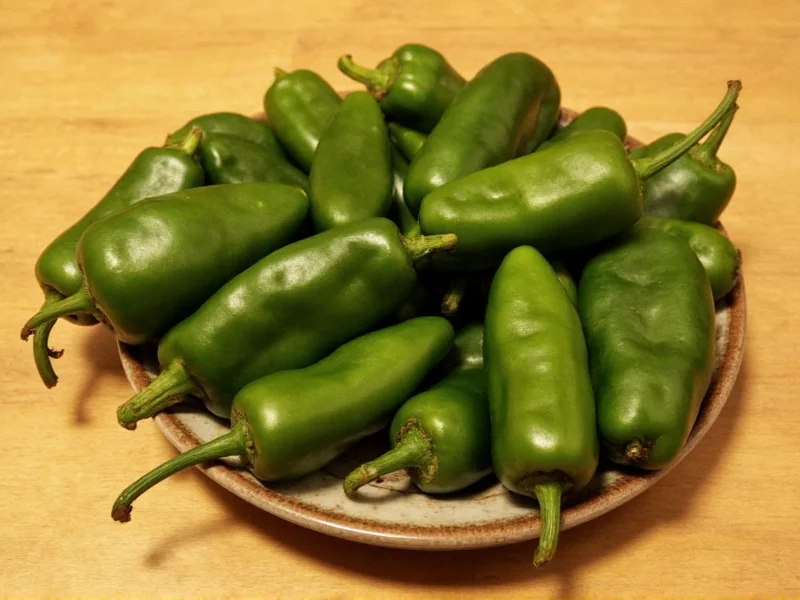Poblano peppers, with their distinctive heart shape and mild to medium heat level, go by several names depending on their preparation stage and regional usage. Understanding these alternative names is essential for navigating recipes, grocery stores, and international markets. This comprehensive guide clarifies all the common and regional names for this versatile Mexican pepper, helping you identify and use them correctly regardless of what label you encounter.
Understanding Poblano Pepper Nomenclature
The naming confusion around poblano peppers stems from culinary traditions, regional dialects, and the transformation that occurs when these peppers are dried. Unlike many peppers that maintain the same name whether fresh or dried, poblanos undergo a significant identity shift when dehydrated. This linguistic evolution reflects their importance in Mexican cuisine, where dried peppers form the foundation of many traditional sauces.
Primary Alternative Names for Poblano Peppers
Ancho Peppers: The Dried Transformation
When poblano peppers are dried, they transform into what's known as ancho peppers (from the Spanish word "ancho" meaning wide or broad). This name change isn't merely semantic—it reflects significant flavor development. The drying process concentrates the pepper's natural sugars and develops complex notes of raisin, tobacco, and berry that aren't present in the fresh form. Ancho peppers typically measure 1,000-2,000 on the Scoville scale, making them milder than many fresh peppers despite their deeper flavor profile.
Chile Ancho and Chile Poblano: Spanish Terminology
In Spanish-speaking regions and authentic Mexican markets, you'll often see these peppers labeled as chile ancho (for the dried version) or chile poblano (for the fresh version). The "chile" prefix simply means pepper in Spanish, distinguishing these from other types of peppers. This terminology helps avoid confusion in regions where multiple pepper varieties exist.
Mulato Peppers: The Darker Cousin
Sometimes confused with anchos, mulato peppers are actually a specific variety of poblano that's left to ripen longer on the plant, resulting in a darker brown color when dried. Mulatos have a more complex flavor profile with notes of chocolate and licorice, making them prized for mole sauces. While all mulatos are poblanos, not all poblanos are mulatos—a subtle but important distinction for serious cooks.
| Name Variation | Form | Flavor Profile | Common Uses |
|---|---|---|---|
| Poblano | Fresh, green | Earthy, mild heat (1,000-2,000 SHU) | Stuffed peppers, rajas, fresh salsas |
| Ancho | Dried, red-brown | Fruity, raisin-like, mild heat | Mole sauces, adobo, spice blends |
| Mulato | Dried, dark brown | Chocolate, licorice notes, sweet heat | Complex moles, specialty sauces |
| Chile Poblano | Fresh | Same as poblano | Same as poblano |
Common Misidentifications and Confusions
One of the most frequent mistakes involves confusing poblanos with pasilla peppers. While both are used in Mexican cuisine, pasillas (also called chilaca peppers when fresh) are long, thin, and wrinkled with a more pronounced heat. The confusion likely stems from some grocery stores mislabeling dried poblanos as pasillas. True pasilla peppers measure 1,000-2,500 SHU when fresh and develop a smokier flavor when dried.
Another common error is assuming that guajillo peppers are related to poblanos. Guajillos are actually dried mirasol peppers with a brighter red color and more pronounced heat (2,500-5,000 SHU). They have a distinct tangy flavor that differs significantly from anchos.
Regional Naming Variations
Across different regions, you might encounter additional names for poblano peppers:
- Chile California: In some parts of Mexico and the southwestern US
- Anaheim peppers: Though technically a different variety, some markets substitute poblanos for Anaheims due to similar heat levels
- Poblano chile: Common in recipe books and culinary contexts
Understanding these regional variations helps when traveling or exploring international recipes. In authentic Mexican markets, asking for "chile poblano" will get you the fresh peppers, while "ancho" will yield the dried version.
Practical Guide to Identifying and Using Poblano Varieties
When shopping for poblano peppers, look for these identifying characteristics:
- Fresh poblanos: Large (3-6 inches), heart-shaped, dark green, thick walls
- Ancho peppers: Dried, wide, flat, deep red-brown, often with a heart shape preserved
- Mulato peppers: Dried, darker brown than anchos, slightly sweeter aroma
For cooking applications, remember that fresh poblanos work best for stuffing and roasting, while anchos shine in sauces where their complex dried flavor can develop. When a recipe calls for "dried poblano," it almost always means ancho peppers. If you can't find anchos specifically, check the international aisle for "chile ancho"—this labeling is more common in authentic markets.
Why the Multiple Names Matter for Cooking
Using the correct pepper variety significantly impacts your dishes. Fresh poblanos provide a crisp texture and mild heat perfect for chiles rellenos, while anchos contribute deep, fruity complexity to mole poblano. Substituting one for the other can dramatically alter flavor profiles. Understanding these naming conventions ensures you select the right ingredient for authentic results, whether you're following a traditional recipe or experimenting with Mexican cuisine.











 浙公网安备
33010002000092号
浙公网安备
33010002000092号 浙B2-20120091-4
浙B2-20120091-4